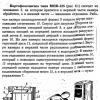Normal baby weight at 1 month. Norms of weight gain and height of newborns by month. Normal for girls
At a pediatrician's appointment, every baby under one year of age is weighed monthly and their height is measured. Why is it so important for doctors to know how a child is growing and how much weight he is gaining? What do these parameters indicate, and what are the anthropometric norms for children of different ages?
Where did weight and height indicators for children come from and why are they needed?
Anthropometric data of a child is one of the main indicators physical development and children's health status. Significant deviations from normal height and weight values in a child almost always indicate the development or presence of certain diseases. So, if a child under one year old, with sufficient nutrition, does not gain weight well, then this may be one of the symptoms of rickets, anemia, immunodeficiency conditions, diseases of the endocrine or central nervous systems.
Significant growth retardation may indicate a lack of somatotropin growth hormone in the body, and obvious excess weight with normal growth and proper nutrition may indicate disturbances in the functioning of the adrenal glands, thyroid gland and even the development of a brain tumor.
In order to detect and begin to treat such dangerous diseases in time, doctors carefully monitor the anthropometric indicators of children from birth. The development standards were compiled by the World Health Organization based on many years of research. In addition to the average normative indicator for each age, the limits of the norms were also calculated. Weight and height above this limit are considered high, and below - low. It is these children that doctors begin to monitor especially closely.
WHO height and weight chart for girls under 1 year of age

According to the norms, a healthy full-term girl is born with a height of 49.2 cm and weighs 3,200 g. This is the average. The lower limit of the norm for a newborn is a height of 47.3 cm and a weight of 2,800 g, and the upper limit is located at values of 51 cm and 3,700 g, respectively. Values outside the lower and upper limits of the norm are marked as very low or too high. Doctors will observe such a newborn and, possibly, further examine her.
In the first month, the newborn should grow 4.5 cm and gain a kilogram. The lower limits of the norm for a one-month-old girl will be 51.7 (height in cm) // 3.600 (weight in grams), and the upper limits will be 55.6 // 4.800.
Normal indicators for a two-month-old baby: 57.1 cm and 5.100 g. The lower limit of the norm: 55//4.500, and the upper limit – 59.1//5.800.
By three months, girls grow to 59.8 cm and weigh 5,900 grams. Indicators less than 57.7 // 5.200 are considered low for a three-month baby, and indicators more than 61.9 // 6.600 are considered high.
Average height and weight for a four-month-old girl: 62.1 cm and 6,400 g. The lower limits of the norm are 59.9 // 5.700, the upper limits are 64.3 // 7.300.
By five months, girls should grow to 64 cm and weigh 6,900 g. Low indicators – parameters less than 61.8//6.100. Indicators 66.3 //7.800 are the upper limits of the norm for a five-month-old girl.
The age of 6 months is considered an important milestone for a child's development. A six-month-old girl should grow to 65.7 cm and weigh 7.300 g. The lower limit is 63.5//6.500, and the upper limit is 68//8.300.
The seven-month-old baby grows to 67.3 cm and weighs 7,600 grams. Indicators below 65 // 6.800 are considered low, and indicators exceeding 69.6 // 8.600 are considered high.
At eight months, the norms are: height - 68.83 cm, and weight - 8 kg. The lower limits of the norm: 66.4//7000, and the upper limits – 71.1//9000.
By nine months, the height should be 70.1 cm, and the baby should weigh 8,200 grams. Low indicators at this age are values less than 67.7 // 7.300, and high indicators are more than 72.6 // 9.300.
According to the norms, a ten-month-old baby should be 71.5 cm tall and weigh 8,500 grams. The lower limits of the norm for ten months are 69//7.500, and the upper limits: 74//9.600.
By eleven months, a girl normally grows to 72.8 cm and weighs 8,700 grams. Indicators less than 70.3//7.700 are considered low. Indicators exceeding 75.3//9.900 will be high.
By the age of one year, girls should grow to 74 cm and weigh 9,000 grams. The lower limit of the norm is considered to be 71.4 //7.900, and the upper limit: 76.6 //10.100.
WHO height and weight chartfor boys up to 1 year

The norms for boys are different from the norms for girls, since boys are usually born slightly larger. Thus, a healthy full-term newborn boy is usually born with a weight of 3,300 grams and a height of 49.9 cm. These indicators are considered the norm. The lower limit of the norm for a newborn is a height of 48 cm and a weight of 2,900 g, and the upper limit is 51.75 cm and 3,900 g, respectively.
In the first month, the baby should grow 4.8 cm and gain 1200 grams. The lower limits of the norm for a one-month-old boy will be 52.8 (height in cm) // 3,900 (weight in grams), and the upper limits will be 56.7 // 5,100.
Normal indicators for a two-month-old toddler: 58.4 cm and 5.600 g. The lower limit of the norm: 56.4//4.900, and the upper limit – 60.4//6.300.
By three months, boys grow to 61.4 cm and weigh 6,400 grams. Low indicators will be parameters below 59.4 // 5.700, and high indicators will be indicators above 63.5 // 7.200.
Average height and weight for a four-month-old boy: 63.9 cm and 7000 g. The lower limits of the norm are 61.8 // 6.300, the upper limits are 66 // 7.800.
By the age of five months, the boy should grow to 65.9 cm and weigh 6,900 grams. Low indicators – parameters less than 63.8 // 6.100. Indicators 68 //7.800 are the upper limits of the norm for a five-month-old baby.
By six months the baby should grow to 67.6 cm and weigh 7,900 grams. The lower limit is 65.5//7.100, and the upper limit is 69.8//8.900.
The seven-month-old boy grows to 69.2 cm and weighs 8,300 grams. Indicators less than 67 // 7.400 will be considered low, and indicators exceeding 71.3 // 9.300 will be considered high.
At eight months, the average for a boy is: height - 70.65 cm, and weight - 8,600 g. The lower limits of the norm: 68.45//7.700, and the upper limits –72.85//9.600.
By nine months, the baby should be 72 cm tall and weigh 8,900 grams. Low indicators will be less than 69.65 // 8.000, and high indicators will be more than 74.3 // 9.900.
A ten-month-old boy should normally be 73.3 cm tall and weigh 9,200 grams. The lower limits of the norm at this age are 71//8.200, and the upper limits: 76//10.200.
By eleven months, the baby normally grows to 74.5 cm and weighs 9,400 grams. Indicators less than 72.2//8.400 are considered low. Indicators exceeding 76.8//10.500 will be high.
According to standards, boys should grow to 75.8 cm per year and weigh 9,700 grams. The lower limit of the norm is considered to be 73.5 //8.700, and the upper limit: 78 //10.800.
Increase muscle mass will help protein soups

Height and weight chart for girls from 1 to 10 years old


The growth of children begins to slow down as soon as the kids turn one, so for children from one to three years old, the norms are no longer determined monthly, but every three months. For children from 3 to 7 years old - once every six months, and for children aged from seven to ten years - the norms change once a year.
By one year and three months, a girl should normally grow to 77.5 cm and weigh 9,600 grams. The lower limits of the norm: 74.83 (height in centimeters) and 8,500 (weight in grams), the upper limits: 80.3//10,900.
The next reference point is determined for the age of one year and six months. Norm: 80.65//10.200. Lower limit: 77.7//9.100. Upper: 83.5//11.600.
At one year and nine months, the norms for girls are 83.65//10.900. Lower limit of normal: 80.6//9.600. Upper limit: 86.7//12.300.
By the age of two, girls normally grow to 86.4 cm and weigh 11,500 grams. The lower limit of the norm: 83.2//10.200. Upper limit: 89.6//13.000.
Average height and weight for babies aged 2 years 3 months: 88.3/12.100. Lower limit: 84.8//10.700. Upper limit: 91.7//13.700.
Girls at 2.5 years old should grow to 90.7 cm and weigh 12,700 grams. The lower limit of the norm: 86.9//11.200. Upper frames: 94.3 // weight 14.400.
At 2.9 years, the average values are: 92.9 // 13.300. Lower limits: 89.3//11.700, upper limits: 96.6//weight 15.100.
Three-year-olds should be 95 cm tall and weigh 13,900 grams. Data below 91.3//12.200 are assessed as low, and figures above 98.8//15.800 are assessed as high.
At 3.5 years old, the standards for a girl are: 99//15,000. The lower line is 95//13.100, and the upper line is 103.1//17.200.
Average height and weight for a four-year-old girl: 102.6//16.100. The lower limits of the norm: 98.4//14.000, and the upper limits of height and weight: 107.1//18.500.
At 4.5 years old, the standards for a girl are: 106.2//17.200. Lower limits: 101.6//14.900, and upper limits: 110.7//19.900.
Average height and weight for a five-year-old girl: 109.4//18.200. The lower limits of the norm: 104.7 // 15.800, and the upper ones: 114.2 // 21.200.
At 5.5 years old, girls should grow to 112.2 cm and weigh 19,000 grams. Parameters less than 107.2 // 16.600 are considered low, and indicators more than 117.1 // 22.200 are considered high.
Standards for six-year-olds: 115.1//20.200. Lower limits: 110//17.500. Upper – 120.2//23.500.
By the age of 6.5 years, girls grow to 118 cm and weigh 21,200 grams. The lower limits at 6.5 years are 112.7 // 18.300, and the upper limits are 123.3 // weight 24.900.
Average height and weight for seven-year-old girls: 120.8 and 23,000. Lower limits: 115.3//21.300, upper limits: 126.3//26.300.
In children over seven years of age, anthropometric indicators are monitored once a year. The standards for eight-year-old girls are 126.6//25,000. The lower limit for eight-year-olds will be 120.8 and 21.400. The upper limit is 132.4//30,000.
Norms for nine-year-olds: 132.45//28.200. Lower limits: 132.5 and 27.900, upper limits – 138.6 // weight 34.000.
A ten-year-old girl should have an average height of 138.55 cm and a weight of 31,900 g. Data below 132.2//27.100 are assessed as low, and figures above 145//38.200 are assessed as high.
Height and weight chart for boys from 1 to 10 years old


Boys at 1.3 years old should reach the parameters 80//10.400. Lower normal value: 76.55 (height in centimeters) and 9.200 (weight in grams), upper limits: 82//11.500.
The next control point is one year and six months. The standard for one and six years is 82.3//10.900. From the border: 79.6//9.800. Up to: 85//12.200.
At 1.9 years old, the standards for boys are 85.2 // 11.500. From the border: 82.4//10.300. Until: 88//12.900.
By the age of two, toddlers normally reach 88//12,200. From the line: 84.4//10.800. Up to 90.5//13.600.
Standard for a 2.3 year old child: 89.6//12.700. From: 86.5//11.300, to: 92.8//14.300.
By the age of 2.5 years, the toddler should grow to 91.9 cm and weigh 13,300 grams. Lower limits for this age: 88.5//11.800. Upper frames: 95.4//15.000.
At the age of 2.9 years, the standards are 94.1/13.800. Lower limits 91//12.300, upper limits 97.6//15.600.
Boys' height at 3 years should be 96.1 cm, weight - 14,300 g. Scores less than 92.4//12.700 will be assessed as low, and scores exceeding 100//16.200 will be assessed as high.
At 3.5 years old, the norm for boys is: 99.9//15.300. From the border: 95.9//13.600, to: 103.8//17.400.
Average height and weight for a four-year-old boy: 103.3//16.300. From the border: 99.1//14.400, to: 107.5//18.600.
At 4.5 years old, the boy’s height reaches 107 cm, and his normal weight should be 17,300 g. The lower level of the norm: 102.25//15.200, and the upper one: 111.1//19.900.
Standards for boys aged 5: 110//18.300. From the bar at: 105.3//16.000 cm, to: 114.6 and 21.000.
By the age of 5.5 years, the standards for boys are 113//19.400. For 5.5 years, indicators less than 108.2//17,000 are considered low, and more than 117.7//22,200 are considered high.
Average height and weight for six year olds: 116/20,500. Bottom bar: 111//18.000. Upper: 120.9//23.500.
By 6.5 years, boys reach parameters 119//21.700. The lower limits for this age are 113.8//19.000, and the upper limits are 124//24.900.
Standards for seven-year-old boys: 121.8//22.900. From the bar at: 116.4//20.000 cm, to: 127//26.400 cm.
By the age of eight, children grow to 127.3 cm and weigh 25,400 grams. The lower standard for eight-year-olds will be 121.5//22.100. Upper – 132.8//29.500.
Average height and weight for nine year olds: 132.6/28.100. Lower limits: 126.6//2.300, upper limits – 138.6//33.000.
At the age of 10, boys should normally reach parameters of 137.8//31.200. Figures below 131.4 and 26.700 are assessed as low, and figures above 144.2//37.000 are considered high.
Height and weight chart for teenage girls

Increase muscle mass will help protein soups

In adolescents, anthropometric data are monitored once a year. For an eleven-year-old girl, the average is 144.5 (height in centimeters)//34.4 (weight in kilograms). Parameters less than 136.2 // 27.8 are considered the lower normative limits, and parameters more than 153.2 // 44.6 are considered the upper ones.
Average height and weight for a twelve-year-old: 150//40.7. The lower limit of the norm: 142.2//31.8, the upper limit: 162.2//51.8.
A thirteen-year-old girl normally has indicators: 155.8//44.3. Lower data bar: 148.3//38.7, upper: 163.7//59.
At 14 years old, the average data for a girl is: 159.5//53.1. Lower limits of the norm: 152.6//43.8, upper: 167.2//64.
By the age of fifteen, the average height of girls reaches 161.6 cm, and the average weight is 55.5 kg. Lower limit of data: 154.4 // 46.8, upper limit: 169.2 // 66.5.
Average height and weight for sixteen-year-old girls: 162.4//56.5. Lower limit: 155.2//48.4, upper – 170.2//67.6.
For girls aged 17, the standard is 163.9//61. Lower limit: 155.8//52.8, upper: 170.5//68.
Height and weight chart for teenage boys

Boys aged 10 to 14 years are slightly behind girls in height; this is a normal phenomenon, since hormonal changes in boys begin a little later than in girls. But after fourteen years, boys begin to grow more rapidly than girls, and by the age of 15 they are ahead of them in terms of growth.
In adolescence, anthropometric indicators significantly depend on genetic predisposition, therefore, when monitoring the physical development of adolescents, it is recommended to focus not so much on the average indicator, but on the normal limits indicated for each age and on the child’s heredity. So, if the father of a young man is 190 cm tall, then the height of 182 cm for the teenager himself at 15 years old can be considered the norm in this case.
For an 11-year-old boy, the average figures are: 143.5 (height in centimeters)//35.5 (weight in kilograms). Parameters less than 134.5//28 are the lower limits of the norm, and parameters exceeding 153//44.9 are the upper limits.
Average height and weight for a twelve-year-old: 149//39.8. From the border: 140//30.7, to: 159.6//50.6.
A thirteen-year-old teenager normally has indicators: 155.5//44.3. From the border: 145.7//33.9, to: 166//59.
At 14 years old, the average is 161.9//49.7. From the border: 152.3//38, to: 172//63.4.
By the age of fifteen, the average height of children is 168 cm, and weight is 55.5 kg. From the border: 158.6//43, to: 177.6//70.
Average height and weight for sixteen-year-old boys: 172.3//66.9. From the border: 163.2//48.4, to 182//76.5.
At seventeen years old, the average height and weight are 176.6//66.9. From the border: 166.7//54.6, to: 186//80.1.
Video “Height and weight of the child, Dr. Komarovsky”
Immediately after the birth of the baby, the doctor informs the happy parents such parameters as the weight and height of the child. In the future, mom and dad will have to carefully monitor the baby's weight gain and height. But why is this so important and what do these parameters depend on?
Child height and weight indicators
There are several factors that influence the rate of weight gain and growth. These are heredity, nutrition and its quality, as well as living conditions. If we talk about height, then genes have the greatest influence - when both parents are tall, then their child will also grow faster. But weight is affected by the quality and quantity of food. If you follow the rules and provide high-quality complementary foods, then there will be no problems with weight gain.
Living conditions are of particular importance. This means that you need to ensure an optimal lifestyle, walk with your child in the fresh air, especially in the sun, as it promotes the production of vitamin D. You need to monitor the health and condition of the baby, then he will grow within normal limits.
Tables: height and weight norms according to WHO
Below you will find detailed information about the average performance of newborn boys and girls up to one year. The only thing that needs to be noted is that the parameters are approximate, since each child’s body is individual.
| Age, months | Weight, kg | Weight gain, g | Height, cm | Height gain, cm |
| 0 | 3,1-3,4 | – | 50-51 | – |
| 1 | 3,7-4,1 | 600 | 54-55 | 3 |
| 2 | 4,5-4,9 | 800 | 55-59 | 3 |
| 3 | 5,2-5,6 | 800 | 60-62 | 2,5 |
| 4 | 5,9-6,3 | 750 | 62-65 | 2,5 |
| 5 | 6,5-6,8 | 700 | 64-68 | 2 |
| 6 | 7,1-7,4 | 650 | 66-70 | 2 |
| 7 | 7,6-8,1 | 600 | 68-72 | 2 |
| 8 | 8,1-8,5 | 550 | 69-74 | 2 |
| 9 | 8,6-9,0 | 500 | 70-75 | 1,5 |
| 10 | 9,1-9,5 | 450 | 71-76 | 1,5 |
| 11 | 9,5-10,0 | 400 | 72-78 | 1,5 |
| 12 | 10,0-10,8 | 350 | 74-80 | 1,5 |
Approximate weight and height gain by month:
As can be seen from the table, in the first year of their life, babies gain approximately seven kilograms of weight and grow up to thirty centimeters. The increase in height and weight is quite active.
Let's take a closer look at the increase by month:
- The first month from birth is characterized by an average increase of 600 grams and from two and a half to three centimeters. The head circumference becomes more rounded, on average this figure increases by one and a half centimeters.
- The second month of life will bring a weight gain of about 700-800 g, and about 3 cm in height. The head circumference increases again - about one and a half centimeters.
- The third is distinguished by an increase of 800 and two and a half centimeters, the head circumference increases again - by one and a half centimeters.
- The fourth – up to 750 grams and 2.5 cm.
- Fifth - plus another seven hundred grams and two and a half centimeters in height.
- Six months – another six hundred grams and two centimeters. Pay attention to the ratio of the width of the shoulders to the length of the baby’s entire body; normally it is 1:4. The head circumference is necessarily less than the chest circumference.
- The seventh month is about 600 g, and two centimeters of growth.
- Eighth - on average 550 grams of increase and 2 cm in height. As you can see, the weight gain is gradually declining.
- Ninth – the baby is another 500 g heavier and 2 cm taller.
- The tenth child is 450 grams heavier and one and a half to two centimeters taller.
- Eleventh - plus four hundred grams and one and a half centimeters.
- A year is another plus three hundred and fifty grams and one and a half centimeters.
WHO height and weight chart for girls under 1 year of age
The rate of development of newborn boys and girls is slightly different. We suggest you familiarize yourself with how much girls gain in weight and height. Remember, these are approximate figures.
Average normal value for baby girls:
| Age, months | Weight, kg | Height, cm |
| 0 | 2,8-3,7 | 47,3-51 |
| 1 | 3,6-4,8 | 51,7-55,6 |
| 2 | 4,5-5,8 | 55-59,1 |
| 3 | 5,2-6,6 | 57,7-61,9 |
| 4 | 5,7-7,3 | 59,9-64,3 |
| 5 | 6,1-7,8 | 61,8-66,2 |
| 6 | 6,5-8,2 | 63,5-68 |
| 7 | 6,8-8,6 | 65-69,6 |
| 8 | 7,0-9,0 | 66,4-71,1 |
| 9 | 7,3-9,3 | 67,7-72,6 |
| 10 | 7,5-9,6 | 69-73,9 |
| 11 | 7,7-9,9 | 70,3-75,3 |
| 12 | 7,9-10,1 | 71,4-76,6 |
Usually, at the end of the year, babies become longer, up to 25 cm, and heavier, up to six kilograms.
WHO table: height and weight for boys under 1 year
It can be seen that the indicators differ from those of girls, but not by much. Check out the average below.
Average normal value for male infants:
| Age, months | Weight, kg | Height, cm |
| 0 | 2,9-3,9 | 48-51,8 |
| 1 | 3,9-5,1 | 52,8-56,7 |
| 2 | 4,9-6,3 | 56,4-60,4 |
| 3 | 5,7-7,2 | 59,4-63,5 |
| 4 | 6,2-7,8 | 61,8-66 |
| 5 | 6,7-8,4 | 63,8-68 |
| 6 | 7,1-8,8 | 65,5-69,8 |
| 7 | 7,4-9,2 | 67-71,3 |
| 8 | 7,7-9,6 | 68,4-72,8 |
| 9 | 8-9,9 | 69,7-74,2 |
| 10 | 8,2-10,2 | 71-75,6 |
| 11 | 8,4-10,5 | 72,2-76,9 |
| 12 | 8,6-10,8 | 73,4-78,1 |
Boys become approximately 25-26 centimeters taller and seven kilograms heavier.
Height and weight chart for girls from 1 to 10 years old
The height and weight of both male and female infants slows down after reaching the age of one year, so these parameters are then measured by year.
Let's look at the weight of babies by year:
| Age in years | Short | Below average | Average | Above average | High | Very tall |
| 1 | 7 | 7,9 | 8,9 | 10,1 | 11,5 | 13,1 |
| 2 | 9 | 10,2 | 11,5 | 13 | 14,8 | 17 |
| 3 | 10,8 | 12,2 | 13,9 | 15,8 | 18,1 | 20,9 |
| 4 | 12,3 | 14 | 16,1 | 18,5 | 21,5 | 25,2 |
| 5 | 13,7 | 15,8 | 18,2 | 21,2 | 24,9 | 29,5 |
| 6 | 15,3 | 17,5 | 20,2 | 23,5 | 27,8 | 33,4 |
| 7 | 16,8 | 19,3 | 22,4 | 26,3 | 31,4 | 38,3 |
| 8 | 18,6 | 21,4 | 25 | 29,7 | 35,8 | 44,1 |
| 9 | 20,8 | 24 | 28,2 | 33,6 | 41 | 51,1 |
| 10 | 23,3 | 27 | 31,9 | 38,2 | 46,9 | 59,2 |
As you can see, there are indicators from low (below normal) to too high (above normal). For example, it is normal for a ten-year-old girl to weigh almost 32 kg, but there is a problem if the reading on the scale exceeds 46 kg.
There is also a table indicating the height of girls:
| Age in years | Short | Below average | Average | Above average | High | Very tall |
| 1 | 68,9 | 71,4 | 74 | 76,6 | 79,2 | 81,7 |
| 2 | 80 | 83,2 | 86,4 | 89,6 | 92,9 | 96,1 |
| 3 | 87,4 | 91,2 | 95,1 | 98,9 | 102,7 | 106 |
| 4 | 94,1 | 98,4 | 109,4 | 107 | 111,3 | 115,7 |
| 5 | 99,9 | 104,7 | 102,7 | 114,2 | 118,9 | 123,7 |
| 6 | 104,9 | 110 | 115,1 | 120,2 | 105,4 | 130,5 |
| 7 | 109,9 | 115,3 | 120,8 | 126,3 | 131,7 | 137,2 |
| 8 | 115 | 120,8 | 126,6 | 132,4 | 138,2 | 143,9 |
| 9 | 120,3 | 126,4 | 132,5 | 138,6 | 144,7 | 150,8 |
| 10 | 125,8 | 132,2 | 138,6 | 145 | 151,4 | 157,8 |
It can be seen that the normal height of a ten-year-old girl is about 139 centimeters, and the highest figure is when the height is above 157. But this parameter is largely influenced by genetics. If mom and dad or one of the parents is tall, or, conversely, short, then the child will be the same. Although it is not impossible for short parents to grow up to have tall children.
Height and weight chart for boys from 1 to 10 years old
So far, boys' figures are not very different from girls' weight and height. Over time, the difference will increase.
Let's look at the weight of guys from one to ten years old:
| Age in years | Short | Below average | Average | Above average | High | Very tall |
| 1 | 7,7 | 8,6 | 9,6 | 10,8 | 12 | 13,3 |
| 2 | 9,7 | 10,8 | 12,2 | 13,6 | 15,3 | 17,1 |
| 3 | 11,3 | 12,7 | 14,3 | 16,2 | 18,3 | 20,7 |
| 4 | 12,7 | 14,4 | 16,3 | 18,6 | 21,2 | 24,2 |
| 5 | 14,1 | 16 | 18,3 | 21 | 24,2 | 27,9 |
| 6 | 15,9 | 18 | 20,5 | 23,5 | 27,1 | 31,5 |
| 7 | 17,7 | 20 | 22,9 | 26,4 | 30,7 | 36,1 |
| 8 | 19,5 | 22,1 | 25,4 | 29,5 | 34,7 | 41,5 |
| 9 | 21,3 | 24,3 | 28,1 | 33 | 39,4 | 48,2 |
| 10 | 23,2 | 26,7 | 31,2 | 37 | 45 | 56,4 |
The growth chart for boys from one year to their first anniversary – ten years – is also interesting:
| Age in years | Short | Below average | Average | Above average | High | Very tall |
| 1 | 71 | 73,4 | 75,7 | 78,1 | 80,5 | 82,9 |
| 2 | 81,7 | 84,8 | 87,8 | 90,9 | 93,9 | 97 |
| 3 | 88,7 | 92,4 | 96,1 | 99,8 | 10,35 | 107,2 |
| 4 | 94,9 | 99,1 | 103,3 | 107,5 | 11,7 | 115,9 |
| 5 | 100,7 | 105,3 | 110 | 114,6 | 119,2 | 123,9 |
| 6 | 106,1 | 111 | 116 | 120,9 | 125,8 | 130,7 |
| 7 | 11,2 | 116,4 | 121,7 | 127 | 132,3 | 137,6 |
| 8 | 116 | 121,6 | 127,3 | 132,9 | 138,6 | 144,2 |
| 9 | 120,5 | 126,6 | 132,6 | 138,6 | 144,6 | 150,6 |
| 10 | 125 | 131,4 | 137,8 | 144,2 | 150,5 | 156,9 |
It is advisable not to measure too often at this stage of life, it is of no benefit. If it is still desirable to monitor your weight in order to prevent problems with obesity, then it makes sense to measure height once every three months until two or three years, and once a year in subsequent years.
Height and weight chart for teenage girls
Teenagers no longer require frequent measurements; it is enough to take them once a year. However, you can control your weight more often if you observe a clear deficiency or excess of this indicator.
The weight norm for girls under 17 years of age is indicated in this table:
| Age | Very low | Short | Below average | Average | Above average | High | Very tall |
| 11 | <24,9 | 24,9-27,8 | 27,8-30,7 | 30,7-38,9 | 38,9-44,6 | 44,6-55,2 | >55,2 |
| 12 | <27,8 | 27,8-31,8 | 31,8-36,0 | 36-45,4 | 45,4-51,8 | 51,8-63,4 | >63,4 |
| 13 | <32 | 32-38,7 | 38,7-43 | 43-52,5 | 52,5-59 | 59-69 | >69 |
| 14 | <37,6 | 37,6-43,8 | 43,8-48,2 | 48,2-58 | 58-64 | 64-72,2 | >72,2 |
| 15 | <42 | 42-46,8 | 46,8-50,6 | 50,6-60,4 | 60,4-66,5 | 66,5-74,9 | >74,9 |
| 16 | <45,2 | 45,2-48,4 | 48,4-51,8 | 51,8-61,3 | 61,3-67,6 | 67,6-75,6 | >75,6 |
| 17 | <46,2 | 46,2-49,2 | 49,2-52,9 | 52,9-61,9 | 61,9-68 | 68-76 | >76 |
Table of growth indicators for adolescent girls:
| Age | Very low | Short | Below average | Average | Above average | High | Very tall |
| 11 | <131,8 | 131,8-136,2 | 136,2-140,2 | 140,2-148,8 | 148,8-153,2 | 153,2-157,7 | >157,7 |
| 12 | <137,6 | 137,6-142,2 | 142,2-145,9 | 145,9-154,2 | 154,2-159,2 | 159,2-163,2 | >163,2 |
| 13 | <143 | 143-148,3 | 148,3-151,8 | 151,8-159,8 | 159,8-163,7 | 163,7-168 | >168 |
| 14 | <147,8 | 147,8-152,6 | 152,6-155,4 | 155,4-163,6 | 163,6-167,2 | 167,2-171,2 | >171,2 |
| 15 | <150,7 | 150,7-154,4 | 154,4-157,2 | 157,2-166 | 166-169,2 | 169,2-173,4 | >173-4 |
| 16 | <151,6 | 151,6-155,2 | 155,2-158 | 158-166,8 | 166,8-170,2 | 170,2-173,8 | >173,8 |
| 17 | <152,2 | 152,2-155,8 | 155,8-158,6 | 158,6-169,2 | 169,2-170,4 | 170,4-174,2 | >174,2 |
It is worth remembering that both weight and height can be inherited, so these figures are only approximate.
Height and weight chart for teenage boys
Surprisingly, from ten to fourteen years old, girls outstrip boys in height. This is due to the fact that boys have not yet begun to undergo hormonal changes in their bodies. But upon reaching the age of fourteen, they begin to grow more actively, completely overtaking girls.
The weight of boys under 17 years old is indicated in the table:
| Age | Very low | Short | Below average | Average | Above average | High | Very tall |
| 11 | <26 | 26-28 | 28-31 | 31-39,9 | 39,9-44,9 | 44,9-51,5 | >51,5 |
| 12 | <28,2 | 28,2-30,7 | 30,7-34,4 | 34,4-45,1 | 45,1-50,6 | 50,6-58,7 | >58,7 |
| 13 | <30,9 | 30,9-33,8 | 33,8-38,0 | 38,0-50,6 | 50,6-56,8 | 56,8-66 | >66 |
| 14 | <34,3 | 34,3-38,0 | 38,0-42,8 | 42,8-56,6 | 56,6-63,4 | 63,4-73,2 | >73,2 |
| 15 | <38,7 | 38,7-43 | 43-48,3 | 48,3-62,8 | 62,8-70 | 70-80,1 | >80,1 |
| 16 | <44 | 44-48,3 | 48,3-54 | 54-69,6 | 69,6-76,5 | 76,5-84,7 | >84,7 |
| 84,717 | <49,3 | 49,3-54,6 | 54,6-59,8 | 59,8-74 | 74-80,1 | 80,1-87,8 | >87,8 |
Height chart for boys under 17 years old:
| Age | Very low | Short | Below average | Average | Above average | High | Very tall |
| 11 | <131,3 | 131,3-134,5 | 134,5-138,5 | 138,5-148,3 | 148,3-152,9 | 152,9-156,2 | >156,2 |
| 12 | <136,2 | 136,2-140 | 140-143,6 | 143,6-154,5 | 154,5-159,5 | 159,5-163,5 | >163,5 |
| 13 | <141,8 | 141,8-145,7 | 145,7-149,8 | 149,8-160,6 | 160,6-166 | 166-170,7 | >170,7 |
| 14 | <148,3 | 148,3-152,3 | 152,3-156,2 | 156,2-167,7 | 167,7-172 | 172-176,7 | >176,7 |
| 15 | <154,6 | 154,6-158,6 | 158,6-162,5 | 162,5-173,5 | 173,5-177,6 | 177,6-181,6 | >181,6 |
| 16 | <158,8 | 158,8-163,2 | 163,2-166,8 | 166,8-177,8 | 177,8-182 | 182-186,3 | >186,3 |
| 17 | <162,8 | 162,8-166,6 | 166,6-171,6 | 171,6-181,6 | 181,6-196 | 196-188,5 | >188,5 |
If there is a genetic predisposition to tall height, that is, if dad is tall, then it is normal to be 180 centimeters tall at the age of fourteen. In this case, look at the maximum, not the average.
Features of height and weight gain in premature infants
In case of premature birth, the baby will gain weight differently. Everything will depend on the so-called gestational age - the week when the baby was born. Typically, the rate of weight gain and growth is different for each case.
Let's find out how premature babies gain weight before the first half of the year:
- If the baby was born weighing up to a kilogram, then he will gain approximately 600 g.
- If from a kilogram to one and a half - about 740-750.
- From one and a half to two and a half kilograms - approximately 870.
And the second half of the year:
- If the birth weight was up to 1 kg, then the child will gain approximately 800 g.
- Larger newborns – 600 g.
During the first year of life, premature babies grow from 25 to 36 centimeters. Already in the second or third year of life they catch up with their peers.
Concomitant diseases and physical development
If a newborn suffers from any disease, then he will gain more slowly in height and weight. Opposite cases are also possible - when, due to illness, a child gains more height than normal.
There are several common diseases:
- Cardiovascular - congenital heart disease and circulatory disorders cause the heart to not work well enough. As a result, organs do not receive the necessary nutrients, physical development is delayed and there is a lack of weight and height.
- Bronchopulmonary is bronchopulmonary dysplasia (BPD), a malformation of the trachea, bronchi, and lungs. They provide negative impact blood circulation is affected, which means that nutrients and oxygen reach the organs in small quantities, which delays the baby’s development.
- Diseases of the gastrointestinal tract - problems with the intestines, esophagus, liver, bile ducts. They can only be resolved surgically early dates after birth. They also negatively affect height and weight gain.
- Endocrine system diseases – hypothyroidism from birth causes too much weight gain due to congestion excess liquid in the body and the occurrence of edema of subcutaneous fat.
In order not to rack your brains over whether your child is growing normally or whether he has any diseases, visit your pediatrician every month. A professional will have time to notice any deviations from the norm.
The influence of type of feeding on newborn weight gain
Previously, it was believed that only one type of feeding influenced weight gain - artificial feeding (feeding infant formula). But now there are cases where a mother overfeeds her baby with breast milk.

The way you feed your baby affects weight gain and growth rate
In both types of feeding, the child may gain weight too rapidly, while growing tall like a normal child. If your child grows one and a half centimeters longer every month up to a year, but at the same time becomes heavier by more than a kilogram, you are probably overfeeding him.
Moderation is important - excess weight causes problems such as delayed motor development and skills. It is more difficult for the baby to roll over, the skill of raising his head is poorly developed, etc. All this is hampered by excess body weight.
A newborn weighs little - is there any reason to worry?
It is body weight that determines the ability to adapt to the outside world. If the toddler was born with a weight within the normal range, then development will occur without problems or delays. If the baby is premature, then his body weight will lag behind the body weight of his peers, although over time he will catch up with them. But what to do with a child who is low weight so that adaptation to the outside world occurs without problems?
- Stay warm. Children with low weight have a very thin layer of subcutaneous fat. This prevents them from retaining heat. Monitor your baby's temperature to prevent hypothermia. Measure the temperature once every six hours - below 36.5, which means you need to warm it up. It is correct not to cover it with a blanket, but to ensure skin-to-skin contact - when the mother places the baby on her chest.
- Feed by the hour. This is necessary, otherwise the baby’s blood glucose will drop, and he will sleep poorly and feel worse. The first days - sixty milliliters of milk per day, then plus 20 ml of milk every day. You need to stop when you reach 200 ml per kg. Meals should be frequent - 8-10 times.
- Massage for appetite – 2.5 kg, and doctors approve of massage, some procedures need to be carried out for general strengthening. Massage helps you gain weight as it improves your appetite. It is carried out only after meals - an hour later. It is advisable to use the services of a professional children's massage therapist, or parents can master the technique themselves. Having lubricated your hands with baby cream, you need to gently massage the child’s muscles from top to bottom - from the neck, then the back, buttocks, legs, then massage the arms and chest.
In conclusion, we can say that if experts have ruled out the possibility of congenital diseases, and the baby weighs less only because of prematurity, then there is no particular reason to worry. Over time, he will catch up with his peers in development. To make this happen, follow the recommendations - do not give the baby the opportunity to become hypothermic, feed him carefully and massage him when the pediatrician allows.
A certain organization of feeding and careful monitoring of the child during the newborn period make it possible to quickly and effectively eliminate the causes of feeding problems before they arise. serious problems, and also help to notice health problems in the child, if any.
The information in this article is general in nature and does not replace medical supervision. If you are concerned about your child's condition, be sure to discuss this with the supervising doctor. If your doctor does not have experience working with infants and breastfeeding women, share the information in this article with your doctor. This will help to more effectively assess the feeding and condition of the infant. Be sure to draw the doctor's attention to the fact that he/she is dealing with an infant. Behavior and condition infant very different from a formula-fed baby.
Behavior of a healthy full-term baby during the newborn period
- In the first days after birth, the baby sucks from the breast colostrum, a super nutritious liquid that protects the child from diseases and allergies ( additional information about colostrum). A newborn baby needs a small amount of colostrum per feeding. On the first day, the baby sucks on average about 1.5 ml of colostrum at a time. However, a newborn can nurse until milk comes in, even every 15-30 minutes, so the total daily volume of colostrum that the baby sucks can be significant.
- After the milk comes in, most newborns nurse at the breast minimum 8-12 times a day. Often infants suckle much more often than 8-12 times. Sometimes it happens that a breastfeeding baby suckles less than 8 times a day, although you need to remember that this is an exception to the rule. Less frequent feedings are considered normal if the baby is gaining weight well. Each newborn develops its own individual sucking routine. In the first weeks, many children are characterized by “crowding” of sucking at certain times of the day (most often in the evening) and longer intervals at other times of the day.
- During growth spurts, babies may suddenly begin to nurse much more frequently than usual. The first growth spurt in children occurs at 2-3 weeks, the next at 6 weeks.
- The duration of sucking during feeding depends on the baby’s age and temperament. As the child gets older, the nature of sucking may change. Some children suck out the milk they need in 5 minutes, some in 45-50.
- A newborn infant is characterized by one segment of continuous sleep per day of 4-5 hours per day. Healthy babies wake up at least once a night to nurse. Nighttime sucking is an important part of a newborn baby's life.
Weight gain and growth of healthy full-term infants
- Healthy full-term newborn babies usually lose weight in the first 3-4 days of life. This is due to the fact that the baby gets rid of excess fluid in the tissues at birth and meconium (first stool).
- A loss of 5-7% of birth weight is normal. A loss of 10% of weight, although considered acceptable, may be a sign of feeding problems. In this case, you must carefully analyze the circumstances of feeding and/or seek help from a specialist.
- Birth weight is restored within 10-14 days of a child’s life. If your baby hasn't reached birth weight, it's time to seek help. At the age of two weeks, it is recommended to check weight gain, discuss feeding arrangements, and make the necessary changes to establish successful feeding. The longer you ignore a problem, the harder it is to fix it later.
- A healthy infant who is breastfeeding well, urinating and having normal bowel movements (see below) should be weighed every month after a check-weigh at two weeks. Regular weighings after each feeding or every day can give a false impression of a breastfeeding baby's weight gain and lead to unjustified refusal to breastfeed.
- Until recently, it was believed that in the first 3-4 months the average weight gain of an infant is approximately 170 grams per week, a minimum of 450-680 grams per month, however, a weight gain of 115-140 grams per week was also considered acceptable until new data were released about weight gain in breastfed children. New data from the World Health Organization puts the average weight gain for infants at 245 grams per week for the first two to three months of life. Infants should gain a minimum of 170-200 grams per week from 2 to 13 weeks.
- Attention! Weight gain is calculated from lowest weight, not birth weight.
- During weighing, it is important to completely undress your baby and remove his diaper.
- Infants grow on average 2.5 cm per month.
- Head circumference increases on average by 1.27 cm per month in the first 6 months.
- Remember that growth charts and standards describe the average height of children in a particular area without taking into account the characteristics of your child. Growth rates cannot be used as the only indicator that a baby is getting enough milk.
Condition of a healthy full-term infant
- The skin of an infant should be soft and elastic. If the child is lightly pinched and released, the skin should immediately return to its normal state (straighten out). If you press on the leather, it should not leave any indentations.
- The mucous membranes of the eyes and mouth should be moist and pink.
- When a child is not sleeping, he gives the impression of being cheerful and active.
- The baby's cry is strong and loud.
Defecation and urination
The number of wet and dirty loaders serves sure sign that the baby is sucking enough milk.
- In the first day or two after birth, an infant should wet one or two diapers per day.
- In the first days after birth, the baby's stool (meconium) is dark, black-green, sticky, and tar-like.
- If the baby sucks well, around the third day the dark stool changes to green (transitional).
- Around the fifth day, the baby's stool turns yellow. Yellow, yellow-green or yellow-brown stool with the consistency of mustard (rather runny, unformed) is normal stool typical for infants. Occasionally, an infant may have green stools. The odor of an infant's stool is not strong or offensive.
- On days 3-4, the number of wet diapers should increase to at least 6 diapers per day.
- With the arrival of milk and the change in color of the stool to yellow, the infant should have bowel movements at least 3-4 times a day every day. Some babies soil their diaper after every feeding. If in the first 4-6 weeks the baby soils fewer diapers, this may be normal, provided frequent feedings (at least 8-12 times a day) and good weight gain.
- After the milk comes in, the infant should wet at least 6-8 cloth diapers or 5-6 disposable ones. If you use disposable diapers, it is important to change them even when they are not completely full to account for the number of urinations. Attention!!! Taking into account wet and dirty diapers as an indicator of milk sufficiency is correct only in the absence of supplementary feeding with water, teas or supplementary feeding with formula.
Signs of possible feeding problems
If you notice one or more of the following symptoms, try to get help assessing your baby's condition and feeding as soon as possible. The sooner you worry, the greater the chances of avoiding supplementary feeding and establishing feeding.
- The child wets less than 5-6 disposable diapers per day.
- The child soils less than 2 diapers per day.
- The baby sleeps too much and sucks too little, or falls asleep immediately after starting feeding.
- The child's jaundice is progressing.
- You have cracked nipples.
- You can't hear the child swallow.
- The baby continues to lose weight after milk comes in (3-5 days after birth).
Indications for supplementation
- If the baby has not gained birth weight within the first 10-14 days.
- If the child gains less than 115-140 grams per week or less than 450-680 grams per month.
- The child's weight falls below the 3 percent line on the child's growth chart.
If the child's condition allows, assessment and organization of feeding, as well as assessment of sucking, should precede the introduction of supplementary feeding. If supplementary feeding is unavoidable, the baby should be supplemented with expressed breast milk. If mother's milk is unavailable for some reason, supplementary feeding is done with donor milk. In the absence of expressed mother's or donor milk, the baby must be supplemented with artificial formula. At the same time as supplementary feeding, you need to continue to establish breastfeeding.
Supplementary feeding must be introduced urgently and under the supervision of a doctor, When
- The baby continues to lose weight after the first week of life.
- The baby did not gain birth weight in the first two weeks.
- Weight loss is more than 10% of the baby's birth weight.
- The child gains little or no growth in height and head circumference.
- The child shows signs of starvation and/or dehydration: sunken fontanel, gray skin, severe drowsiness, loss of fat under the skin, dark color and strong odor of urine or no urine at all, no or little stool.
Weight and height gain in newborns is the most accessible indicator of child development. The pediatrician measures them every month to a year and records the results in the child's medical record. If the indicators differ significantly from the norms established by doctors, the baby is prescribed additional examinations to identify the causes of the deviations.
After birth, the baby undergoes the process of developing and establishing the digestive system, balancing metabolism and normalizing heat exchange. The baby begins to gradually gain weight, he grows and develops.
Baby's weight in the first month
Optimal weight gain in the first month depends on the baby’s type of nutrition ( breast-feeding, artificial, mixed), his weight at birth, the number of feedings, the health of the child and the presence of a healthy appetite. How does a baby’s weight change from birth to one month:
- the first three days after birth, the child loses from 5 to 8% of body weight;
- in the first week the baby gains about 100 grams of weight;
- in the second week the child grows, develops, gains up to 250 grams;
- by the end of the first month, the total weight gain of the child will be from 600 to 800 grams.
Weight at discharge
The baby's weight at discharge is less than at birth. This is a normal phenomenon and occurs for a number of reasons:
- the baby changes his environment, this is stressful for him, so there is a slight weight loss;
- a child switches to a new type of diet, it takes some time for his body to readjust;
- the baby loses a small amount of fluid through the skin (it is thin and tender), his intestines are freed from original feces - meconium.
Weight gain in a newborn is usually calculated from the minimum indicator, i.e. not from birth weight, but from discharge weight. This figure is indicated on the child's card. However, according to reviews from mothers, many local pediatricians, when examining a child in the first month, still calculate the increase in weight at birth.
Norm of weight gain in newborns by month
After about a week, the newborn regains the lost grams and his weight becomes the same as at birth. Maximum weight gain occurs in the first three months. At this age, the baby still moves little, but eats a lot and sleeps a lot.
Indicative table of weight gain in newborns by month
| 1 | 700 |
| 2 | 750 |
| 3 | 750 |
From the fourth month, the child tries to crawl and roll over; greater activity leads to high energy expenditure and consumption of fat reserves. The approximate rate of weight gain in infants by month from four months to six months is from 400 to 600 grams, and from six months to nine months it decreases to 300 - 500 grams. At the age of nine months to a year, the increase is even smaller: from 200 to 400 grams.
WHO table of weight gain in infants by month
| Baby's age (in months) | Monthly weight gain (in grams) |
|---|---|
| 1 | 700 |
| 2 | 750 |
| 3 | 750 |
| 4 | 700 |
| 5 | 700 |
| 6 | 650 |
| 7 | 550 |
| 8 | 550 |
| 9 | 550 |
| 10 | 500 |
| 11 | 450 |
| 12 | 400 |
Deviations from the norm - when to worry
The norms for weight gain in children under one year old established by the World Health Organization (WHO) are conditional. It is always necessary to take into account the developmental characteristics of each individual child.
If your baby is noticeably underweight, this may be the result of:
- Stress of the mother or illness of the child. If your baby has a poor appetite after illness, he will slowly gain weight. And if the mother is nervous and worried, this affects the quantity and quality of milk, which also leads to malnutrition of the child.
- Mom has low milk production. In this case, you need to take measures to restore lactation.
- The mother may put the baby to the breast incorrectly, he gets tired of sucking in vain and does not get enough.
- The number of feedings is not enough. The average feeding rate is 12, lasting from 15 to 20 minutes.
- If the child is active, moves a lot, he is given gymnastics and massage, this also helps to lose weight, but does not affect the baby’s health (additional feedings may be needed to restore the baby’s strength and energy).
- From danger signs weight loss may be due to dysbiosis and incomplete absorption of milk.
- Neurological pathologies can prevent the baby from sucking properly; the feeding process is not easy for such children.
- Vaccinations sometimes cause weight loss.
If the weight gain over the months of a child under one year of age significantly exceeds the norm, be sure to pay attention to possible problems:
- Hormonal disorders can lead to weight gain in a child. This may be the result of the mother taking hormonal drugs or be a symptom of thyroid problems in the baby.
- Overfeeding can result in inadequate weight gain. This happens to formula-fed babies. In this case, change the mixture, adjust the number and volume of feedings.
Height
Baby's height at birth
In addition to weight, an important indicator of a child’s development is his height. For boys, the normal height at birth is 48-52 cm, and for girls 48-51 cm. The following factors influence the baby’s growth:
- Heredity. Tall parents and children are usually born with height above average, which is a type of norm. As in the case of parents with short stature.
- A mother’s balanced diet during pregnancy affects the height and weight of the newborn.
- If the baby is healthy, he has no congenital diseases, his growth at birth will be within normal limits and will continue to develop within the established limits.
Growth gain in newborns by month
According to WHO charts, a child grows by about 25 cm by the first year of life:
| Baby's age (in months) | Monthly height increase (in cm) |
|---|---|
| 1 | 3 |
| 2 | 3 |
| 3 | 2,5 |
| 4 | 2,5 |
| 5 | 2 |
| 6 | 2 |
| 7 | 2 |
| 8 | 2 |
| 9 | 1,5 |
| 10 | 1,5 |
| 11 | 1,5 |
| 12 | 1,5 |
Most parents are interested in the physical health of their children. The weight and height of a child under 10 years of age are his key parameters for both girls and boys. The evaluation criterion is a special scale or auxiliary tables compiled by the World Health Organization. What values will be optimal for different ages of both sexes?
Measuring a child’s physical appearance provides insight into the progress of development.
Development indicators for girls and boys in the first year of life
Weight by month
There is a separate table showing weight gain for babies up to one year:
Norm and limits of deviation of a child’s weight in the first year of life
Height and weight of a child from one year to 10 years
Very low and high numbers indicate the presence of deviations; those that are above and below the average are considered variants of the norm.
The height and weight table for children under 10 years of age is compiled separately for boys and separately for girls and will help you independently determine whether the process of your child’s physical development needs to be adjusted.
Indicator table for boys
Taking into account the regular weight and height gain of young men, WHO has compiled the following table of height and weight of boys under 10 years of age:
Growth indicators of development of boys under ten years of age
Weight development indicators for boys under ten years of age
The height and weight table for boys aged 10 years shows the proportional ratio for a given time period:
Indicator table for girls
Unlike boys, girls develop much faster. Therefore, it should not be surprising that children different genders children of the same age may be inferior in performance to each other. The height and weight of girls under 10 years old is presented in this diagram:
Growth indicators of girls under ten years of age
Weight development indicators for girls under ten years of age
How do children grow from one to three years old?
The WHO table of average values will help you monitor the timely increase in the required centimeters and kilograms:
| Age | Height, cm | Weight, kg |
||
Boys | Boys | |||
| 1 year | ||||
| 1 year 3 months | ||||
| 1 year 6 months | ||||
| 1 year 9 months | ||||
| 2 years | ||||
| 2 years 3 months | ||||
| 2 years 6 months | ||||
| 2 years 9 months | ||||
| 3 years | ||||
Features of development of children from 3 to 5 years old
The physical development of a 3-5 year old child is determined by several parameters:
- 3 years - height 96 cm+\- 4 cm, weight 12 kg +\-1 kg, chest girth 51 cm+\-2 cm, head circumference 48 cm, presence of about 20 baby teeth;
- 4-5 years - 104 cm+\-4 cm, 17 kg+\-1 kg, chest 55 cm+\-2 cm, head 50 cm, teeth have not yet been replaced with permanent ones;
- the skull of a three-year-old child is equal to 80% of the volume of an adult’s skull, the spine is unstable, and bones and joints are easily deformed from negative external influences;
- very rapid blood circulation corresponds to a pressure of 95 to 58, increased excitability is observed, leading to rapid fatigue.
How do girls and boys grow from 5 to 10 years old?
Starting from the age of 5, the child’s body gradually transforms into a teenager’s. The height and weight standards for children aged 10 years, as well as during the primary school period, are:
- 6 years - the body becomes 6-7 cm taller and 2.5-3 kg heavier, average height is 107-121 cm, weight 18-28 kg, chest circumference 56-65 cm;
- 7 years - another 8-10 cm are added in height, 2.5-3 cm to the chest, body length is 114-128 cm, the baby weighs 20-30 kg;
- 8 years - changes characteristic of puberty are not yet noticeable, 21-32 kg and 119-134 cm;
- 9 years - children grow to 125-140 cm and 24-36 kg, respectively;
- 10 years - averages - 129-146 cm and 25-39 kg.
For a simpler understanding of child development, here is a table of the height and weight of children 10 years old:
Boys | ||||
Weight, kg | Height, cm | Weight, kg | Height, cm |
|



















